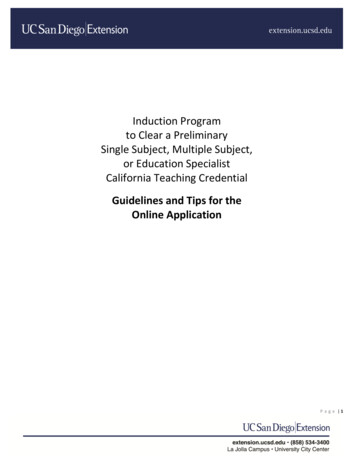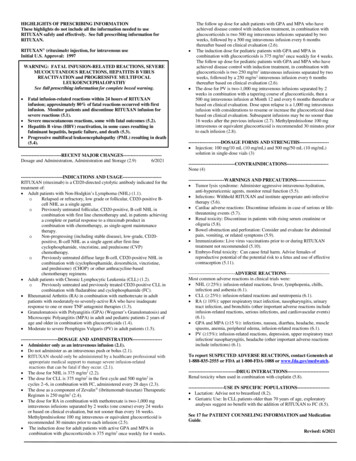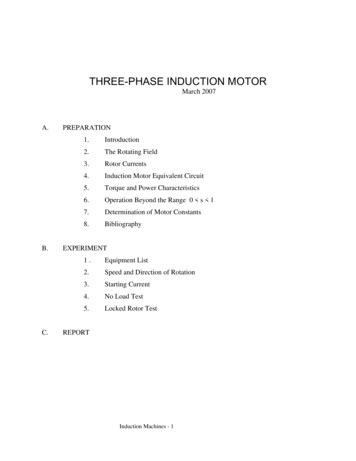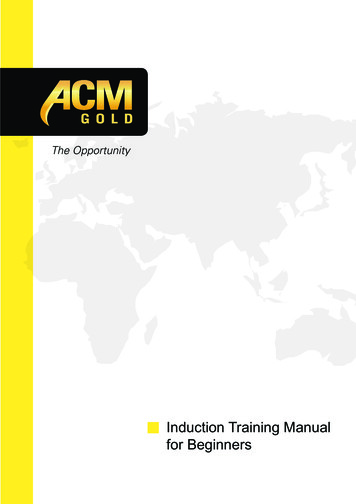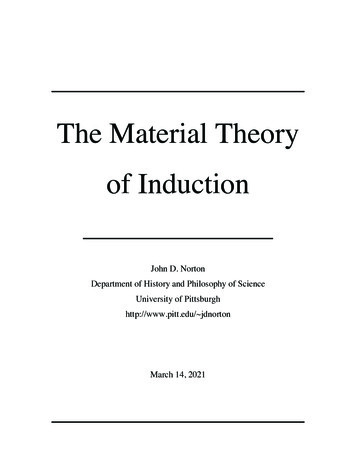
Transcription
The Material Theoryof InductionJohn D. NortonDepartment of History and Philosophy of ScienceUniversity of Pittsburghhttp://www.pitt.edu/ jdnortonMarch 14, 2021
VersionApril 24, 2020Minor typo corrections April 30, 2020.Corrections in response to reviewers, March 14, 2021.
June 25, 2018; April 24, 2020PrefaceThe project for this volume started modestly. It was classified as the “little inductionbook” in my original notes. The plan was to write a short and easy introduction to the main ideasof the material theory of induction. As the writing proceeded, those modest ambitions weresupplanted by increasingly ambitious ones until the project had ballooned into somethingenormous. There were three parts. The first dealt with qualitative notions of inductive inferenceand the second with quantitative notions. They correspond roughly to the chapters 1-9 and 10-16of the present work. There was no space for the third part that dealt with the global structure ofinductive support. It will be the subject of another volume. Readers anxious for a taste of itscontent should consult the Epilog here.The principal idea of the material theory of induction is that background facts obtainingin some domain tell us which are the good and which are the bad inductive inferences in thatdomain. This conception differs fundamentally from virtually all approaches to inductiveinference in the present literature. There the good inductive inferences are distinguished from thebad by checking whether the inference has appropriate formal properties, such as fitting to anapproved inferential template or preferred calculus. Because the divergence from the presentliterature occurs at such a fundamental level, my experience is that philosophers of science whowork in inductive inference have trouble approaching the theory. The difficulty, I conjecture, isthat we approach new ideas by trying to assimilate them into our existing conceptual system,which has in turn been tailored to the details of our own research agendas. What are we to dowhen an idea arrives that does not neatly fit into any of our existing conceptual pigeon holes? Isthis material theory just another variant of enumerative induction? Is it inference to the bestexplanation with some alternative notion of explanation? Is it the proposal of a non-probabilistic,mathematical calculus of inductive inference? Or is it another tiresome skeptical assault oninductive inference and the evidential grounding of science?It is none of these. The slogans “All induction is local.” and “No universal rules ofinduction.” may appear skeptical. They are not. They are an attempt to diagnose why inductiveinference has, for thousands of years, been a locus of trouble for philosophers. The wordsPrefaceiii
“induction” and “problem” are nearest neighbors in any philosophical lexicon. This enduring,troublesome character derives, I believe, from a foundational mistake that was made at the outset.We tried and continue to try to understand inductive inference using the formal methods thathave proven so fertile for deductive inference. While different formal approaches may work indifferent domains, the formal conception is the wrong approach for understanding inductiveinference overall. Choosing it is responsible for the enduring trouble. The material approachoffers an alternative foundation for inductive inference that repairs the trouble.A prominent corollary of the material approach is that probabilistic methods do notprovide a universally applicable account of inductive inference. For those enamored byBayesianism, it will be tempting to drop the material theory into the pigeon hole occupied byformal luddites whose opposition to all mathematical approaches is grounded in a visceralantipathy to them. I do not belong in that company, as readers will see if they consult Chapter 16.My work elsewhere in history and philosophy of physics is very hospitable to mathematicalmethods, whose power continues to astonish me. I am especially impressed with the power ofprobabilistic methods in statistical physics. When they are applicable, they are wonders.My advocacy and defense of probabilistic approaches extends to inductive inference, butonly on a case by case basis. When probabilistic methods are warranted in some domain, theywork and they work very well. Where Bayesians err is in their belief that probabilistic methodsare a universal default that can be applied everywhere, automatically. Instead, my view is thatprobabilistic methods can be applied only in some domain when the background facts of thatdomain authorize it. We cannot just assume that they apply in some new domain. We have apositive obligation to show that they are warranted by background facts in each case.A consequence is that I wilt every time I see yet another paper that promises a Bayesiananalysis of fiddle-de-dee, especially when fiddle-de-dee is some aspect of inductive inference orevidential support. The pretense is that the Bayesian analysis will provide universalunderstanding. It cannot do this since Bayesian analysis cannot be applied everywhere. Insteadwe are given a few elementary results in the probability calculus. The terms of these formulaeare then matched tendentiously with terms of art from fiddle-de-dee. The relabeled formulae aresupposed to provide insight, but they only give us the illusion of understanding.The style of analysis of this work falls within my conception of history and philosophy ofscience. It begins by taking the pertinent science seriously. That is especially important when itPrefaceiv
comes to inductive inference since the evidential successes of modern science are extraordinary.That we philosophers of science are struggling to vindicate these successes is more acommentary on our failures than any failure of the sciences. The chapters that follow are rich inexamples from science. I lean towards grasping the science by exploring its history, for anemphasis on the history provides some protection from the inevitable, modern textbooksimplifications of relations of inductive support. The presence of the history is not meredecoration. It is essential to understanding of the evidential relations in the science.It is customary in a preface to acknowledge those who have been helpful in the book’sproject. This project has many distinct parts, commonly divided naturally by chapter. Rather thandelivering here a long but opaque list of names, I have acknowledged in individual chaptersthose who have been especially helpful in those parts. Those acknowledgments fall short ofnaming all those who have provided support, encouragement or helpful critical responses. To allthose I have failed to name, I offer apologies and thanks.On October 27-28, 2018, there was a conference on the material theory of induction atthe Center for Philosophy of Science, University of Pittsburgh, called “Norton for Everyone: TheMaterial Theory of Induction and Beyond.” It was beyond extraordinary and humbling for me tohave the material theory of induction scrutinized by so many talented and accomplishedphilosophers of science. May I thank once again all those who participated? Its organizers wereJohn Earman, Bryan W. Roberts and Elay Shech. Speakers and discussion leaders were JonathanBain, Nora Boyd, Jeremy Butterfield, Richard Dawid, Siska De Baerdemaeker, Balazs Gyenis,Eric Hatleback, Leah Henderson, Michel Janssen, Molly Kao, Jonathan Livengood, WendyParker, Dasha Pruss, Bryan W. Roberts, Elay Shech and David Wallace. Many more werepresent and contributed most valuably. With apologies to those omitted, my faulty memorymeans that this list is only partial: Harvey Brown, Hasok Chang, Pat Corvini, Nick Huggett,Shahin Kaveh, Edouard Machery, John McCaskey, Tom Pashby, Willy Penn, Mike Tamir,Jennifer Whyte and Jim Woodward.Subsequently Elay Shech and Wendy Parker solicited contributions from the speakersand elsewhere for a special issue on the material theory of induction in Studies in History andPhilosophy of Science. The now complete special issue includes an editors’ introduction, fifteenPrefacev
papers and a response to each from me.1 Once again, I thank the contributors for their interestand efforts. I reserve special thanks for Elay and Wendy for having undertaken the burden oforganizing this special issue and shepherding its contributions through to completion.When this manuscript was submitted to BSPSOpen, several anonymous reviewers for thepress read the manuscript carefully and sympathetically. I thank them for their helpful remarksand corrections, which have been incorporated as best I can into the manuscript.Finally, I offer the most profound gratitude to my wife Eve who has provided a happyhome for my body and heart through the years of the writing of this work and many before it.Those who know the joy of true and enduring love will understand what that means. Nocombination of words can properly express it.1 The collection of papers can be accessed at the journal’s website ial-issue/10205S9XGWGPrefacevi
Contentsvii
ContentsProlog1. The Material Theory of Induction Stated and IllustratedInductive inferences are not warranted by conformity with some universally applicable formal schema.They are warranted by background facts. The theory is illustrated with Marie Curie's inductive inferenceover the crystallographic properties of radium chloride.2. What Powers Inductive Inference?The principal arguments for the material theory are given. Any particular inductive inference can failreliably if we try it in a universe hostile to it. That the universe is hospitable to the inference is a contingent,factual matter and is the fact that warrants it.The material theory asserts that there are no universal rules of inductive inference. All induction is local.Chapters 3-9 will show how popular and apparently universal rules of inductive inference are defeasibleand that their warrants in individual domains are best understood as deriving from particular backgroundfacts.3. Replicability of ExperimentThere is no universal inductive principle in science formulated in terms of replicability of experiment.Replication is not guaranteed to have inductive force. When it does, the force derives from backgroundfacts peculiar to the case at hand.4. AnalogyEfforts to characterize good analogical inferences by their form have collapsed under the massive weight ofthe endless complexity needed to formulate a viable, general rule. For scientists, analogies are facts notargument forms, which fits nicely with the material view.5. Epistemic Virtues and Epistemic Values: A Skeptical CritiqueTalk of epistemic values in inductive inference misleads by suggesting that our preference for simplertheories is akin to a free choice, such as being a vegetarian. The better word is criterion, since they are notfreely chose, but must prove their mettle in guiding us to the truth.6. Simplicity as a SurrogateThere is no viable principle that attaches simpler hypotheses to the truth. Appeals to simplicity are shortcutsthat disguise more complicated appeals to background facts.7. Simplicity in Model SelectionStatistical techniques, such as the Akaike Information Criterion, do not vindicate appeals to simplicity as ageneral principle. AIC depends on certain strong, background assumptions independent of simplicity. Weimpose a simplicity interpretation on the formula it produces.Contentsviii
8. Inference to the Best Explanation: The General Account9. Inference to the Best Explanation: ExamplesThere is no clearly defined relation of explanation that confers special inductive support on somehypotheses or theories. The important, canonical examples of IBE can be accommodated better by simplerschemes involving background facts. The successful hypotheses or theories accommodate the evidence.The major burden in real cases in science is to show that competing accounts fail, either by contradictingthe evidence or taking on evidential debt.Chapters 10-16 address Bayesian confirmation theory, which has become the default account of inductiveinference in philosophy of science, in spite of its weaknesses. Chapters 10, 11 and 12 address generalissues. Chapters 13-16 display systems in which probabilistic representation of inductive strengths ofsupport fails.10. Why Not BayesWhile probabilistic analysis of inductive inference can be very successful in certain domains, it must fail asthe universal logic of inductive inference. For an inductive logic must constrain systems beyond merelogical consistency. The resulting contingent restrictions will only obtain in some domains. Proofs of thenecessity of probabilistic accounts fail since they require assumptions as strong as the result they seek toestablish.11. Circularity in the Scoring Rule Vindication of ProbabilitiesThe scoring rule approach employs only the notion of accuracy and claims that probabilistic credencesdominate. This chapter shows that accuracy provides little. The result really comes from an unjustified finetuning of the scoring rule to a predetermined result.12. No Place to Stand: The Incompleteness of All Calculi of Inductive InferenceAn inductively complete calculus of inductive inference can take the totality of evidential facts of scienceand, from them alone, determine the appropriate strengths of evidential support for the hypotheses andtheories of science. This chapter reviews informally a proof given elsewhere that no calculus of inductiveinference, probabilistic or not, can be complete.13. Infinite Lottery MachinesSuch machines choose among a countable infinity of outcomes without favor. While the example is used toimpugn countable additivity, it actually also precludes even finite additivity.14. Uncountable ProblemsIf we enlarge the outcome spaces to continuum size, we find further inductive problems that cannot beaccommodated by a proba
means that this list is only partial: Harvey Brown, Hasok Chang, Pat Corvini, Nick Huggett, Shahin Kaveh, Edouard Machery, John McCaskey, Tom Pashby, Willy Penn, Mike Tamir, Jennifer Whyte and Jim Woodward. Subsequently Elay Shech and Wendy Parker solicited contributions from the speakers






